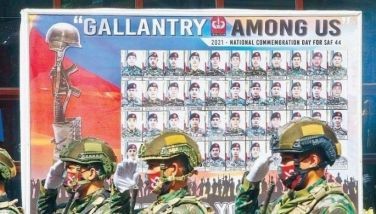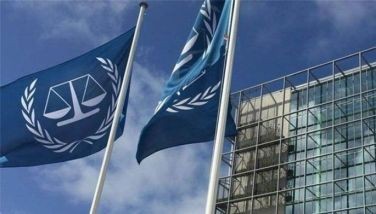SuperFerry sinking a terrorist attack

Six of the al-Qaeda-linked militants have been charged with the bombing, which the government had initially rejected as an empty boast by the Abu Sayyaf to prop up its image.
"We have solved the SuperFerry bombing," said Mrs. Arroyo, whose announcement marked the first 100 days of her new term. "Today, criminal charges were filed against the six perpetrators. These are the same people responsible for the Dos Palmas kidnapping."
Three Americans, two of whom later died, and 17 Filipinos from the Palawan beach resort were abducted in 2001.
An official inquiry concluded "that the fire on board the SuperFerry 14 was caused by an explosion due to an explosive device," said Superintendent Leopoldo Bataoil, Philippine National Police (PNP) spokesman.
Police have implemented security measures "to prevent similar" attacks, he added.
Sea marshals and bomb-sniffing dogs now accompany ferries, while the government imposed tougher screening of passengers and cargos. Port workers are also being trained on security, Bataoil said.
The two men – Redendo Cain Dellosa and Alhamser Manatad Limbong – who planted the bomb are already under government custody, while the four others, including Abu Sayyaf leaders Khaddafy Janjalani and Abu Sulaiman, remain at large, Mrs. Arroyo said.
The President has ordered security forces to intensify the massive manhunt for Janjalani and Sulaiman.
The accused were charged with multiple murder, multiple frustrated murder and multiple attempted murder. Limbong allegedly beheaded hostage Guillermo Sobero, one of three Americans in the resort abduction.
"The arrest of the two suspects illustrates the fact that in the first 100 days of this administration, we have been able to stabilize our security situation," Mrs. Arroyo said, adding that she is asking Congress to pass an anti-terrorism bill "to strengthen our fight against terrorism."
The Abu Sayyaf, which is on Washington’s list of international terror groups, claimed responsibility immediately after the fire, saying it planted a bomb inside a television set that one of its members carried aboard.
However, the government played down the possibility of a terrorist attack, despite the Abu Sayyaf claim.
A blast and fire struck the ferry, carrying about 900 people, an hour after it left Manila for Bacolod and General Santos cities as it neared Corregidor island at the mouth of Manila Bay.
Officials have said 118 people were killed and 16 others were missing and believed dead.
Transportation and Communications Secretary Leandro Mendoza said investigators believe the SuperFerry 14 was targeted because its owner WG&A did not comply with an Abu Sayyaf letter last year demanding protection money.
Janjalani had demanded $1 million for "unhampered use of the waters" around Mindanao, Bataoil said. "Otherwise, they would do anything to disrupt and destroy their business interest."
WG&A declined to comment on the finding, saying it has not yet been furnished a copy of the investigation’s report.
Explosive find
Malacañang initially played down the possibility of a terror attack, but in March announced the arrests of six Abu Sayyaf members – including Dellosa who allegedly confessed to planting the bomb – and the discovery of a cache of TNT that police said was to be used to bomb malls, trains, an oil depot, foreign embassies and other targets in Metro Manila.
Even after the confession, the government said it still wasn’t certain that the Abu Sayyaf claims were true.
A preliminary investigation had indicated two possible causes – a bomb or a gas explosion.
Mendoza said the investigation had taken so long because the ferry, which ended up lying on its right side in shallow water, had to be towed and the wreckage was so twisted.
The ship’s captain, other officers and crew reported smelling gunpowder as smoke engulfed the vessel after a powerful blast. Other witnesses said it originated from a part of the ship where the Abu Sayyaf claimed to have planted a bomb.
Arthur Gosingan, a coast guard commandant, said investigators determined the explosion inside the ferry was caused by a bomb, matching Dellosa’s confession.
Security officials have said Dellosa confessed after his arrest that he stashed about eight pounds (3.6 kilograms) of TNT in a TV set that he carried onto the ferry. Dellosa later claimed he was tortured into signing a confession.
Dellosa allegedly underwent explosives training last year with an Indonesian member of the Muslim militant group Jemaah Islamiyah on Sulu island, where the Abu Sayyaf is active, Rafanan said in a report.
The charges against the six accused were based on the testimony of a sole witness, Muslim convert Walter Villanueva, who alleged that Dellosa told him about the plot.
Dellosa even boasted how he prepared the bomb, Villanueva added.
He said Dellosa had spent the night before the bombing at his Quezon City home. Dellosa told him he was traveling to Mindanao the following day.
Villanueva said he received a phone call from Dellosa on the evening of Feb. 27, informing him about the plot’s success.
From Bandits To Terrorists?
If the Abu Sayyaf was indeed responsible, the SuperFerry 14 sinking will go onto the rolls as the world’s fourth deadliest terrorist attack since the Sept. 11, 2001, attacks on the United States and Asia’s worst since the 2002 Bali bombings in Indonesia.
The Philippine government brushes off the Abu Sayyaf as a mere bandit group because of the ransoms it raked in from its kidnapping sprees.
However, the SuperFerry 14 would confirm fears of regional intelligence officials and terrorism experts that the Abu Sayyaf is evolving into a terrorist group in the same league as Jemaah Islamiyah, al-Qaeda’s arm in Southeast Asia that is allegedly allied with the separatist Moro Islamic Liberation Front. The MILF denies harboring terrorists.
"A new leadership has abandoned the kidnapping that brought in millions of dollars in ransom. Now, the group is returning to its Islamic roots and is using the familiar weapons of terror – bombing and assassination – in an attempt to achieve an independent Muslim republic in the southern Philippines," Time magazine wrote in August. "Abu Sayyaf already claims to be connected to al-Qaeda. And although regional intelligence officials downplay that assertion, they are worried that Abu Sayyaf could become what it already says it is."
A terrorism expert, Zachary Abuza, author of a forthcoming book on Islamic militancy in the southern Philippines, says if Abu Sayyaf successfully becomes the main Islamic radical group in the area, it could become a "magnet for dissatisfaction," attracting hundreds of young Muslims.
Aside from bombings, the Abu Sayyaf is allegedly resorting to assassination to achieve its goals.
"They are setting up an urban assassination squad called Fisabillilah, or ‘The Path of God,’" Kit Colliers, of the Australian National University in Canberra, told Time.
Colliers has written a detailed report on Islamic militancy and terrorism in the Philippines for the International Crisis Group.
Philippine security officials say half a dozen alleged Abu Sayyaf operatives arrested in June for possession of materials for explosives were members of the squad.
Repeated assaults by troops on Abu Sayyaf camps on Sulu and Basilan islands – with advice, training and logistics support from US special forces – are believed to have weakened the group.
Meanwhile, government anti-terrorism agents have in their custody a suspected female Muslim terrorist said to be involved in the deadly 2003 bombings in Davao City that claimed 38 lives and wounded over 100 others.
Military and police sources claimed the suspect, whom they identified as Monawara Yusop, is undergoing interrogation after she was arrested last week along with a certain Mentang in a raid in Paco, Manila.
Mentang has already admitted to being a Jemaah Islamiyah-trained bomber, sources said.
An Abu Sayyaf member in Sulu has also surrendered to troops, the military announced yesterday.
Brig. Gen. Agustin Demaala identified the guerrilla as Mando Talib Asari, a native of Talipao, Sulu. Demaala heads Task Force Comet, whose unit is tasked with hunting down the group.
Asari’s involvement in the Abu Sayyaf was still being determined by military investigators, Demaala said. – With Aurea Calica, Roel Pareño, Christina Mendez, Jaime Laude, AFP
- Latest
- Trending






























